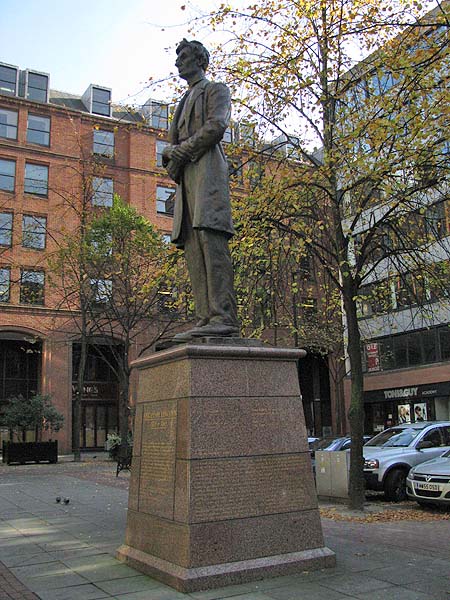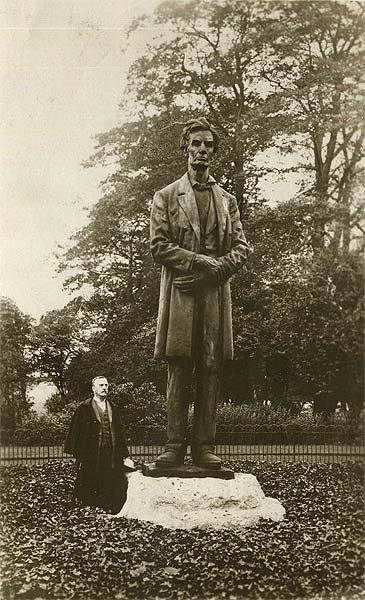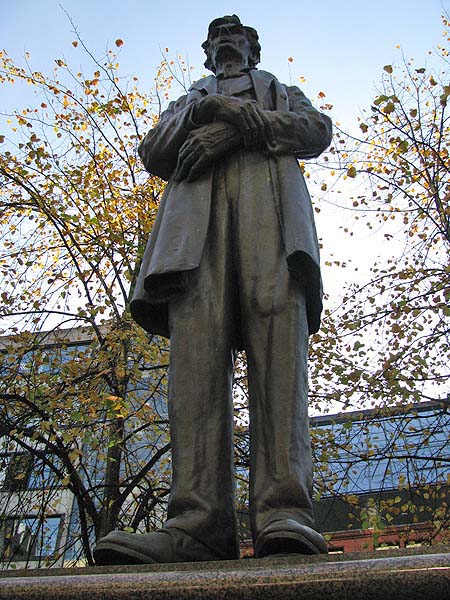|
Abraham Lincoln
 Brazennoze Street runs
between Albert Square and Deansgate and for much of
its length it is a pedestrianized walkway. Along the
way the street opens out into a square called Lincoln
Square after the monument that was placed there in
1986. Why is Abraham Lincoln standing on a plinth in
the middle of Manchester?
 The statue was one of two presented to the people
of England by Charles Phelps Taft, the son of
William Howard Taft who was President of the United
States. Charles Taft was himself an official in the
US government and mayor of the city of Cincinnati,
Ohio. The gift was meant to be a symbol of
Anglo-American unity. How this statue ended up in
Manchester was a little convoluted. One of the
statues was given to London; the other was
originally destined for Liverpool. In 1918 the
members of the Manchester Art Gallery committee
provided the money to bring it to the city. This
statue was created by George Barnard and is replica
of one in Cincinnati, Ohio. Originally it was to be
erected in London but when the president's son
Robert heard this he intervened. He didn't like the
statue and it became known as the "stomach ache
statue" because of the placement of the hands. As a
result this statue went to Manchester and London got
a statue that is a replica of a larger one by
Augustus Saint-Gaudens in Chicago's Lincoln Park.
Manchester's statue was erected in 1919 in Platt
Field's park and it stayed there until 1986.
The postcard image
above shows the statue in Platt Fields although I'm
a bit disturbed by the relative sizes of the statue
and the man standing next to it. The statue is
4 meters high which suggests that the man is no
taller than 1.5 metres or just under 5 feet
tall. He certainly makes the statue look
impressive. So that explains how it came to placed in Lincoln Square but not why. The why is explained by the inscription on the plinth. It is dedicated to: "the support that the working people of Manchester gave in their fight for the abolition of slavery during the American Civil War.......By supporting the union under President Lincoln at a time when there was an economic blockade of the southern states the Lancashire cotton workers were denied access to raw cotton which caused considerable unemployment throughout the cotton industry." To what degree the people of Lancashire gave this support willingly is questionable. Lincoln's Union Army blockaded the southern ports preventing the Confederate supporters from trading their cotton and causing what was known as the Cotton Famine in the UK. By November 1862, three fifths of the labour force, 331,000 men and women, were idle. The British Government was encouraged to take action to overturn the blockade and riots broke out because of the hardship suffered by the workers. The Confederate Flag flew on some Lancashire mills.
A recent article in the Manchester Evening News about the statue was prompted by the activities around the 200th anniversary of the abolition of slavery. It read: "The statue of Abraham Lincoln in Brazenose Street has suffered from the ravages of pollution and the weather, leaving it almost impossible to read the words on its plaque. Local government minister Phil Woolas, MP for Oldham East and Saddleworth, was recently at Manchester Museum to mark the bicentenary of the Abolition of the Slave Trade Act 1807, when he was told about the state of the plaque. After a plea from museum boss Nick Merriden, Mr Woolas has agreed to pay 'whatever it takes' to keep alive the message on the red granite plaque. Mr Woolas said: "It's shameful, especially as we mark the 200 anniversary, that people cannot read this plaque." |

